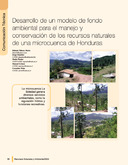| dc.contributor.author | Tábora Merlo, F. | |
| dc.contributor.author | Faustino, J. | |
| dc.contributor.author | Piedra, M. | |
| dc.contributor.author | Gómez, M. | |
| dc.contributor.author | Prins, C. | |
| dc.date.accessioned | 2020-10-26T21:58:48Z | |
| dc.date.available | 2020-10-26T21:58:48Z | |
| dc.date.issued | 2004-03 | |
| dc.identifier.issn | e-ISSN: 1021-0164 | ISSN |
| dc.identifier.uri | https://repositorio.catie.ac.cr/handle/11554/9782 | |
| dc.description | 6 páginas, 4 ilustraciones, 1 tabulaciones, 5 referencias. | |
| dc.description.abstract | El artículo considera el ecoturismo como una fuente potencial de ingresos para la creación de un fondo ambiental en la microcuenca La Soledad, Honduras. Para conocer los ingresos que esta actividad generaría, se estimó la voluntad de pago (VDP) de turistas nacionales y extranjeros. Los resultados muestran que el 93 porciento de los turistas nacionales estarían dispuestos a pagar Lps. 2,00 por la conservación de los recursos naturales de la microcuenca, mientras que el 91 porciento pagaría Lps. 10,00 por la entrada a un sendero. Asimismo el 88 porciento de los turistas extranjeros estaría dispuesto a pagar 2,00 dólares por la primera situación y sólo el 56 porciento de ellos pagaría 10,00 dólares por la segunda opción. De acuerdo con los resultados del análisis financiero, los ingresos potenciales al fondo serían de 105 206,67 dólares durante el primer año y 128 550,25 dólares en el año siete, lo que prueba que habría recursos suficientes para la creación de un fondo ambiental (FA). El sistema de Pago por Servicios Ambientales (PSA) cubriría actividades como protección de bosques, reforestación y adopción de sistemas agroforestales (SAF). Los montos propuestos a pagar son: 168,7 dólares/ha/año para los SAF, 40,00 dólares/ha/año para la protección del bosque y 0.82 dólares/árbol plantado/año | |
| dc.description.abstract | This article considers ecoturism as a potential source of income for the creation of an environmental fund, in the Soledad microwatershed in Honduras. To assess the potential revenue we first estimate national and foreign tourist's willingness to pay (WTP). Results show that 93 percent of national tourists are willing to pay Lps.2,00 for the conservation of the watershed natural resources and 91percent are willing to pay 2,00 dollars for an entrance ticket to a natural trail. Like wise 88 percent of the foreign tourists are willing to pay 2,00 dollars in the first situation whereas only 56 percent of them would pay 10,00 dollars for the second alternative. The financial analysis shows that the potential income for the fund will be 105206.67 dollars during the first year and 128 550.25 dollars at the year seventh. It is evident that this activity will provide the financial resources necessary for the creation of an environmental fund. The environmental services to be paid are: forest protection, reforestation and the use of agroforestry systems. The payment proposed is: 168,7 dollars/ha/year for agroforestry systems, 40,00 dollars/ha/year for forest protection and 0,82 dollars for planted tree/year. | |
| dc.language.iso | es | es_ES |
| dc.publisher | CATIE, Turrialba (Costa Rica) | |
| dc.relation.ispartof | Recursos Naturales y Ambiente Número 41 (Marzo 2004), páginas 96-101 | |
| dc.rights | info:eu-repo/semantics/openAccess | es_ES |
| dc.subject | CUENCAS HIDROGRAFICAS | |
| dc.subject | RECURSOS NATURALES | |
| dc.subject | CONSERVACION DE LOS RECURSOS | |
| dc.subject | ORDENACION DE RECURSOS | |
| dc.subject | TURISMO | |
| dc.subject | FINANCIAMIENTO | |
| dc.subject | HONDURAS | |
| dc.subject | SERVICIOS AMBIENTALES | |
| dc.subject | ORDENACION FORESTAL | |
| dc.title | Desarrollo de un modelo de fondo ambiental para el manejo y conservación de los recursos naturales de una microcuenca de Honduras | es_ES |
| dc.title.alternative | Developing an enviromental fund for the management and conservation of natural resources in a micro-watershed in Honduras | es_ES |
| dc.type | Artículo | es_ES |


